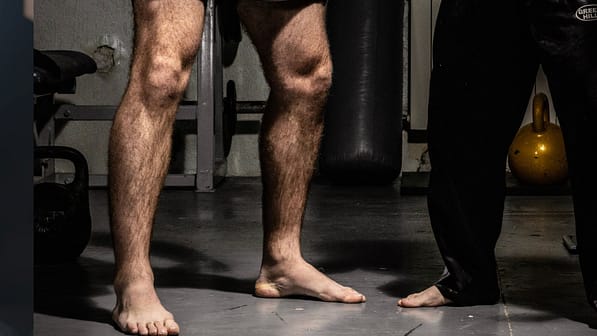Performing squats with your heels staying grounded is essential for maintaining stability and balance. However, some individuals may encounter difficulty in achieving this.
In this article, we will explore the potential reasons behind this issue, including limited ankle mobility, weakness in the lower body, and improper squatting technique. Additionally, we will provide practical solutions to address these challenges.
Heels lifting off the ground when squatting.
Difficulty in performing squats with heels lifting can be due to limited ankle mobility, lower body weakness, or improper squatting technique. Address this by improving ankle mobility through exercises like calf stretches, strengthen your lower body with exercises like leg press and lunges, practice proper form by engaging your core and maintaining a neutral spine, and consider using weightlifting shoes or elevating your heels. Consult a fitness professional if needed.
1. Limited Ankle Mobility.
Proper ankle mobility is a crucial factor for maintaining a stable squat position.
If your ankles lack the necessary flexibility, your heels may lift off the ground as you descend into the squat.
This limitation can be attributed to tight calf muscles or joint restrictions.
Limited ankle mobility can significantly impact your ability to perform squats with grounded heels.
Here are examples of how tight calf muscles or joint restrictions can contribute to this limitation:
Tight Calf Muscles:
When your calf muscles are tight, they can restrict the range of motion in your ankles, making it challenging to achieve proper ankle dorsiflexion during squats.
This limited dorsiflexion prevents you from keeping your heels down. An example of tight calf muscles causing limited ankle mobility is if you regularly engage in activities like running or wearing high heels, which can lead to tightness in the calf muscles over time.
Joint Restrictions:
Joint restrictions in the ankle can also limit ankle mobility and hinder your ability to perform squats with heels on the ground.
Conditions such as ankle arthritis, previous ankle injuries, or general joint stiffness can impede the smooth movement of the ankle joint.
These restrictions may prevent you from achieving the necessary ankle dorsiflexion, resulting in lifted heels during squats.
Here are some exercises to improve ankle mobility:
Calf Stretches: Perform calf stretches by standing with one foot in front of the other and leaning forward while keeping the back heel grounded. Hold the stretch for about 30 seconds on each leg, repeating multiple times.
Ankle Mobility Drills: Engage in ankle mobility drills such as ankle circles, alphabet writing with your toes, or standing calf raises on an elevated surface to enhance ankle flexibility.
Foam Rolling the Calves: Use a foam roller to massage and release tension in the calf muscles. Roll the foam roller up and down the length of your calves, applying gentle pressure.

2. Weakness in the Lower Body.
Squatting requires strength in various muscle groups, including the quadriceps, hamstrings, glutes, and calves.
Weakness in any of these muscles can lead to an imbalance and difficulty keeping your heels down during the movement.
Weakness in the lower body muscles can contribute to difficulty in keeping your heels down during squats. Here are examples of how weakness in specific muscle groups can affect your squat performance:
Weak Quadriceps:
The quadriceps are the muscles at the front of your thighs and play a significant role in squatting. If your quadriceps are weak, they may struggle to maintain control and stability during the movement.
As a result, your weight may shift forward onto the toes, causing your heels to lift off the ground.
Weak Hamstrings:
The hamstrings, located at the back of your thighs, are also important for squatting. Weak hamstrings can lead to an imbalance in the muscles surrounding the knee joint, making it difficult to maintain proper alignment and control. This imbalance can contribute to the lifting of heels during squats.
Weak Glutes:
The gluteal muscles, including the gluteus maximus and medius, are responsible for hip extension and stabilization.
Weak glutes can affect your ability to generate power and maintain a stable squat position. Insufficient glute strength may cause compensation patterns, such as leaning too far forward or relying on other muscles, leading to heel lifting.
Weak Calves:
The calf muscles, specifically the gastrocnemius and soleus, are involved in maintaining ankle stability and control during squats. Weak calves can limit the ability to properly engage the lower leg muscles, resulting in difficulty keeping the heels down.
Consider incorporating the following strengthening exercises into your routine:
Leg Press: Utilize the leg press machine to strengthen your quadriceps and glutes. Sit with your feet shoulder-width apart on the platform, then push the platform away from your body using your legs, ensuring your heels stay in contact with the footplate.
Lunges: Perform walking lunges or stationary lunges to target the quadriceps, hamstrings, and glutes. Take a step forward with one leg, lowering your body until both knees form 90-degree angles. Push back up through the heel of the front foot to the starting position and repeat on the other leg.
Step-Ups: Find a sturdy step or platform and step onto it with one foot. Push through the heel of the elevated foot to lift your body upward, then lower yourself back down. Alternate legs and repeat for several sets.
Calf Raises: Strengthen your calf muscles by performing calf raises. Stand with the balls of your feet on the edge of a step or platform, allowing your heels to hang off. Rise onto your tiptoes, then lower your heels below the step level before repeating.
3. Improper Squatting Technique.
Using incorrect squatting form another thing that can contribute to your heels lifting off the ground when squatting.
Improper squatting technique can lead to lifted heels during the squats movement.
Here are examples of common technique mistakes that can contribute to this issue:
Leaning Too Far Forward:
When you lean excessively forward during a squat, it shifts your center of gravity and puts increased pressure on the front of your feet.
This forward weight shift can cause your heels to lift off the ground. Leaning too far forward may occur due to lack of core stability, poor hip mobility, or incorrect body positioning.
Shifting Weight onto the Toes:
If you distribute your weight predominantly onto the toes instead of evenly through your entire foot, it can disrupt the balance and stability required to keep your heels down.
Shifting weight onto the toes can be a result of poor body awareness, weak lower body muscles, or lack of proper cueing.
Not Engaging the Proper Muscles Effectively:
Squats involve the activation of various muscle groups, including the quadriceps, hamstrings, glutes, and core.
Failing to engage these muscles effectively can lead to compensatory movements, such as using the lower back instead of the lower body muscles.
This improper muscle activation can affect your squat form and contribute to lifted heels.
Here are some common technique mistakes to avoid:
Leaning too far forward: Maintain a neutral spine and avoid excessive forward lean. Focus on pushing your hips back as you descend into the squat, keeping your chest lifted and core engaged.
Shifting weight onto the toes: Distribute your weight evenly through your entire foot, with a slight emphasis on the heels. Avoid shifting the weight forward onto the toes during the squat.
Engaging the proper muscles effectively: Ensure that you engage the correct muscles during the squat. Focus on activating your quadriceps, hamstrings, glutes, and core to maintain stability throughout the movement.
4. Additional Measures.
If you continue to struggle with maintaining proper form and keeping your heels grounded during squats, consider the following measures:
Elevate Your Heels: Use weightlifting shoes that have an elevated heel, which can assist in achieving better ankle mobility and allow for a more upright posture during squats.
Alternatively, you can place small weight plates or a wedge under your heels to provide a slight elevation and help maintain balance.
Seek Professional Guidance: If you are uncertain about your squatting technique or experience persistent discomfort or pain, it is recommended to consult with a qualified fitness professional, such as a personal trainer or physical therapist.
They can assess your specific situation, identify any underlying issues, and provide tailored guidance to address your needs effectively.
Here’s a tabular format summarizing the reasons, examples, and considerations for experiencing difficulty performing squats with lifted heels:
| Reasons | Examples | Considerations |
|---|---|---|
| Limited ankle mobility | Tight calf muscles | – Perform calf stretches
– Engage in ankle mobility drills – Foam roll the calves – Consider using weightlifting shoes or elevating the heels – Seek professional guidance if necessary |
| Joint restrictions | ||
| Weakness in the lower body | Weak quadriceps | – Leg press
– Squats with lighter weights or bodyweight – Lunges |
| Weak hamstrings | ||
| Weak glutes | ||
| Weak calves | ||
| Improper squatting technique | Leaning too far forward | – Focus on maintaining a neutral spine
– Engage the core muscles – Push the hips back – Seek feedback on form from a fitness professional |
| Shifting weight onto the toes | ||
| Not engaging proper muscles effectively |
Considerations:
- Gradually work on improving ankle mobility and lower body strength.
- Focus on maintaining proper form and technique during squats.
- Listen to your body and avoid pushing through pain or discomfort.
- Seek guidance from a qualified fitness professional for personalized advice and form correction.
- Pay attention to any pre-existing conditions or injuries that may affect your squat performance.
- Take a progressive approach, gradually increasing weights and difficulty levels as your strength and mobility improve.
Conclusion.
Difficulty performing squats without your heels lifting off the ground can be attributed to limited ankle mobility, weakness in the lower body, or improper squatting technique.
By addressing these factors through ankle mobility exercises, strengthening exercises, practicing proper form, and seeking professional guidance if necessary, you can work towards improving your squatting performance and maintaining proper balance throughout the movement.
Remember to prioritize safety, listen to your body, and make gradual progress in your training journey.

Hey there, it’s Mike Rrsq, the Editor-in-Chief over at Jsquat.com, and I’m absolutely obsessed with all things squat fitness! I’ve been lucky enough to get some serious recognition for my work in this field. With a solid background in the fitness and wellness industry, I’ve been there right from the get-go, helping shape this website into what it is today.
You see, I’m not just the boss around here; I’m also a passionate contributor. I love sharing my insights through my articles, and trust me, they’re not your run-of-the-mill stuff. Each piece I write is a labor of love, filled with my expertise and real-world experience in the fitness universe. So, if you’re into fitness and looking for some inspiration, you’re in the right place!


